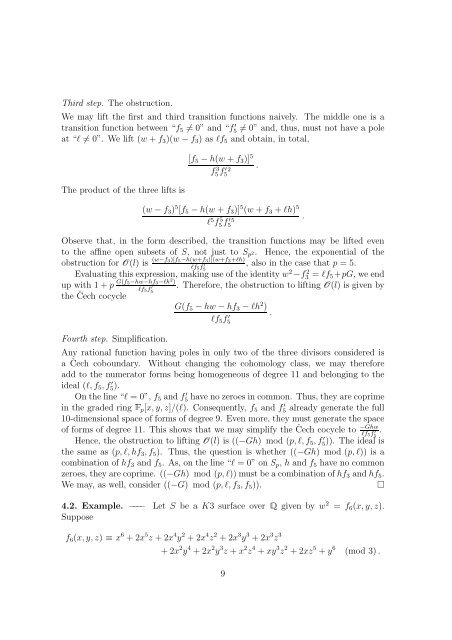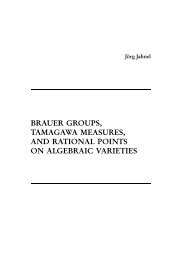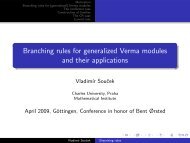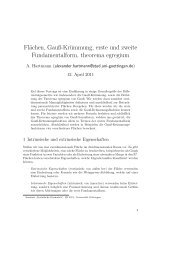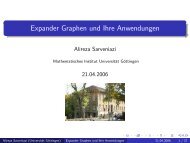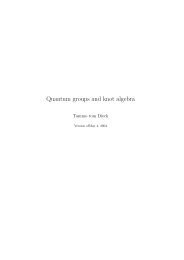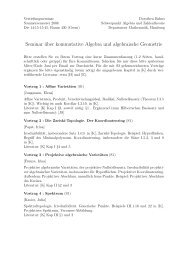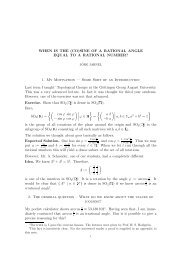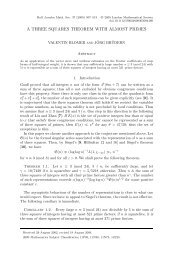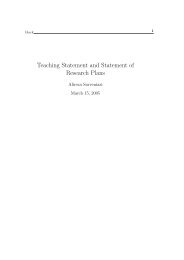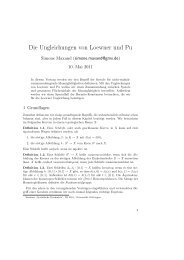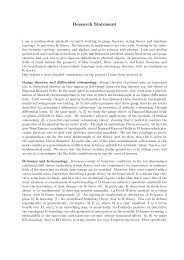The Picard group of a K3 surface and its reduction modulo p
The Picard group of a K3 surface and its reduction modulo p
The Picard group of a K3 surface and its reduction modulo p
You also want an ePaper? Increase the reach of your titles
YUMPU automatically turns print PDFs into web optimized ePapers that Google loves.
Third step. <strong>The</strong> obstruction.<br />
We may lift the first <strong>and</strong> third transition functions naively. <strong>The</strong> middle one is a<br />
transition function between “f 5 ≠ 0” <strong>and</strong> “f ′ 5 ≠ 0” <strong>and</strong>, thus, must not have a pole<br />
at “l ≠ 0”. We lift (w + f 3 )(w − f 3 ) as lf 5 <strong>and</strong> obtain, in total,<br />
<strong>The</strong> product <strong>of</strong> the three lifts is<br />
[f 5 − h(w + f 3 )] 5<br />
f 3 5 f ′ 5 2 .<br />
(w − f 3 ) 5 [f 5 − h(w + f 3 )] 5 (w + f 3 + lh) 5<br />
l 5 f 5 5 f ′ 5 5 .<br />
Observe that, in the form described, the transition functions may be lifted even<br />
to the affine open subsets <strong>of</strong> S, not just to S p 2. Hence, the exponential <strong>of</strong> the<br />
obstruction for O(l) is (w−f 3)[f 5 −h(w+f 3 )](w+f 3 +lh)<br />
lf 5<br />
, also in the case that p = 5.<br />
f 5<br />
′<br />
Evaluating this expression, making use <strong>of</strong> the identity w 2 −f3 2 = lf 5 +pG, we end<br />
up with 1 + p G(f 5−hw−hf 3 −lh 2 )<br />
lf 5<br />
. <strong>The</strong>refore, the obstruction to lifting O(l) is given by<br />
f 5<br />
′<br />
the Čech cocycle G(f 5 − hw − hf 3 − lh 2 )<br />
.<br />
lf 5 f 5<br />
′<br />
Fourth step. Simplification.<br />
Any rational function having poles in only two <strong>of</strong> the three divisors considered is<br />
a Čech coboundary. Without changing the cohomology class, we may therefore<br />
add to the numerator forms being homogeneous <strong>of</strong> degree 11 <strong>and</strong> belonging to the<br />
ideal (l, f 5 , f 5).<br />
′<br />
On the line “l = 0”, f 5 <strong>and</strong> f 5 ′ have no zeroes in common. Thus, they are coprime<br />
in the graded ringp[x, y, z]/(l). Consequently, f 5 <strong>and</strong> f 5 ′ already generate the full<br />
10-dimensional space <strong>of</strong> forms <strong>of</strong> degree 9. Even more, they must generate the space<br />
−Ghw<br />
<strong>of</strong> forms <strong>of</strong> degree 11. This shows that we may simplify the Čech cocycle to<br />
lf 5<br />
.<br />
f 5<br />
′<br />
Hence, the obstruction to lifting O(l) is ((−Gh) mod (p, l, f 5 , f 5 ′ )). <strong>The</strong> ideal is<br />
the same as (p, l, hf 3 , f 5 ). Thus, the question is whether ((−Gh) mod (p, l)) is a<br />
combination <strong>of</strong> hf 3 <strong>and</strong> f 5 . As, on the line “l = 0” on S p , h <strong>and</strong> f 5 have no common<br />
zeroes, they are coprime. ((−Gh) mod (p, l)) must be a combination <strong>of</strong> hf 3 <strong>and</strong> hf 5 .<br />
We may, as well, consider ((−G) mod (p, l, f 3 , f 5 )).<br />
□<br />
4.2. Example. –––– Let S be a <strong>K3</strong> <strong>surface</strong> overÉgiven by w 2 = f 6 (x, y, z).<br />
Suppose<br />
f 6 (x, y, z) ≡ x 6 + 2x 5 z + 2x 4 y 2 + 2x 4 z 2 + 2x 3 y 3 + 2x 3 z 3<br />
+ 2x 2 y 4 + 2x 2 y 3 z + x 2 z 4 + xy 3 z 2 + 2xz 5 + y 6 (mod 3) .<br />
9


